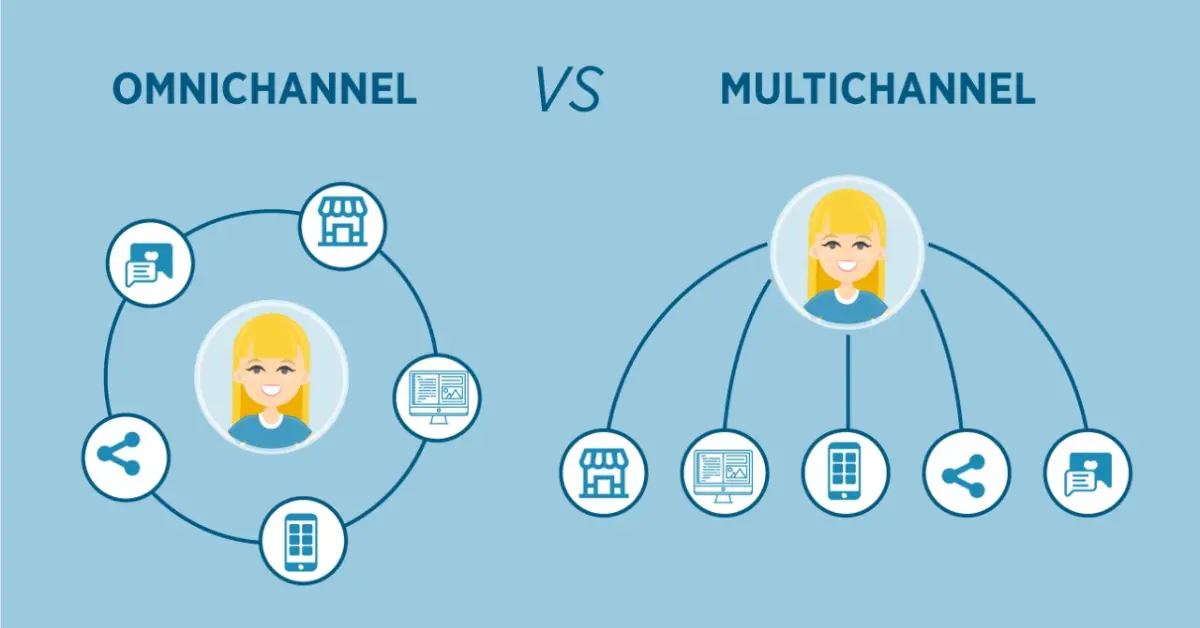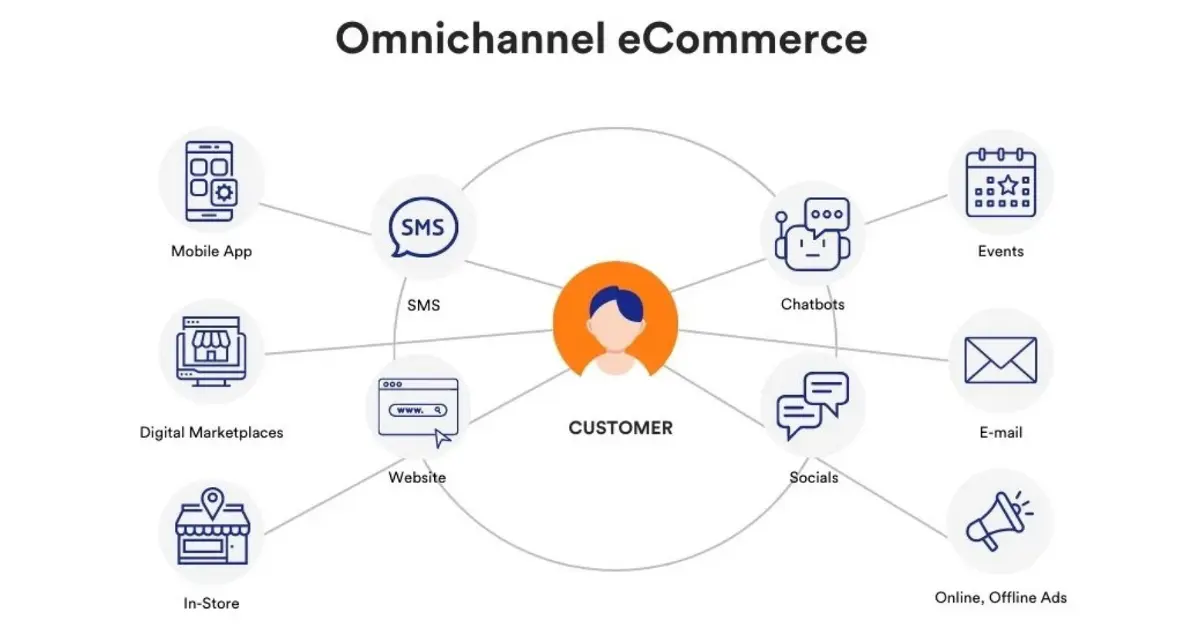
In today's digital age, the world of e-commerce overflowing with potential for businesses to succeed. With a greater spotlight on online buying, businesses must develop solid plans to match customers' changing demands and tastes. Multichannel and omnichannel strategies are two popular techniques in e-commerce, with each presenting distinct benefits and challenges. In this blog post, we'll look at the differences between multichannel and omnichannel e-commerce to assist businesses identify which approach is best for their growth and success
Understanding Multichannel
E-Commerce

Multichannel e-commerce sells products on websites, marketplaces (Shopee, Lazada, TikTok Shop, Zalora and more), social media platforms (Facebook & Instagram), and offline stores.. Each channel is a separate sales channel for the business. Multichannel e-commerce aims to reach more customers by expanding sales channels.
Advantages of Multichannel E-Commerce
Increased reach
Multiple channels allow businesses to connect with varied demographics and groups of consumers, broadening their market reach beyond geographical boundaries.
Risk mitigation
Using numerous platforms minimizes reliance on a single channel. It also reduces the risks associated with algorithm modifications, regulatory updates, and platform disruptions.
Improved brand visibility
A multi-platform presence boosts brand awareness and credibility with buyers.

Challenges of Multichannel E-Commerce
Channel management complexity
Managing inventory, orders, and interactions with customers across multiple channels can be complex, necessitating specialized IT solutions.
Inconsistent brand experience
Keeping brand messaging and experience consistent across platforms can be difficult, leading to customer confusion or disengagement.
Unsynchronized inventory management
Managing inventories across different channels can be tricky. Maintaining precise stock levels, coordinating replenishment, and avoiding overselling or stockouts necessitate the use of strong inventory management systems and practices, like what we shared in our previous blog post.
Order fulfillment efficiency
Fulfilling orders from several channels is challenging. Filling orders quickly, reducing shipping costs, and meeting customer expectations require sellers to simplify fulfillment operations.
Exploring Omnichannel E-Commerce

Omnichannel e-commerce unifies shopping across all channels, unlike multichannel. It promotes an integrated strategy that connects channels, letting customers to seamlessly switch between online and offline experiences while preserving consistency in their buying process.
Advantages of Omnichannel E-Commerce
Unified customer experience
Omnichannel strategies emphasize a consistent and personalized buying experience across every channel to build consumer loyalty.
Data-driven insights
By integrating data from multiple channels, businesses gain deeper insights into customer behavior, preferences, and purchasing patterns, enabling more informed decision-making and targeted marketing campaigns.
Enhanced customer engagement
Omnichannel strategies allow businesses to engage with customers at every stage of the purchasing process, from online browsing to physical store visits, developing deeper ties and increasing sales.

In our previous blog post, we elaborated on the effectiveness and advantages of the omnichannel e-commerce approach, delving into further details.
Choosing the Right Strategy

Ultimately, the decision between multichannel and omnichannel e-commerce is based on a number of requirements, including the type of business, target audience, available resources, and long-term goals. While multichannel tactics provide greater reach and flexibility, omnichannel approaches focus on seamless integration and an improved customer experience.
E-commerce success requires adaptation, agility, and a deep grasp of customer wants and preferences, regardless of strategy. Businesses can achieve sustained success in the digital marketplace by carefully assessing the pros and cons of multichannel and omnichannel e-commerce.
Examples
Situation 1: Sarah with two marketplaces
Sarah must optimize her presence in two markets with limited resources. Sarah must allocate resources strategically between the two platforms. Massive integration for an omnichannel approach may not be feasible given her markets' manageability.
A multichannel approach lets Sarah adapt her technique to each platform's dynamics. Sarah may maximize her reach and sales by evaluating the demographics, product categories, and selling models of her chosen platforms. Sarah should consider scalability while managing her two marketplaces. She may need to rethink her strategy and switch to omnichannel for better scalability and integration as her business grows.
Situation 2: Adam with multiple marketplaces
Adam must properly manage multiple markets while maximizing their opportunities. Adam manages integration and data use across multiple channels. An omnichannel approach like Sellercraft centralizes management and simplifies operations, saving him from hiring more staff to manage several channels.
Adam's brand integrity depends on an omnichannel strategy to ensure identical branding and customer experiences across numerous marketplaces. Integrating customers across channels needs strategic planning, and an omnichannel approach ensures seamless interactions and consistent promotions, increasing customer engagement and loyalty.
Adam may also stand out and maintain buyers in a competitive market by offering higher value and convenience through an omnichannel approach. Adam's company needs scalability and strengthening, and an omnichannel strategy allows him to effortlessly integrate new channels and benefit from emerging opportunities in the dynamic e-commerce landscape.
Conclusion
In conclusion, the choice between multichannel and omnichannel e-commerce hinges on various factors such as business type, target audience, available resources, and long-term goals. While multichannel strategies offer broader reach and flexibility, omnichannel approaches prioritize seamless integration and enhanced customer experience. Successful e-commerce adaptation requires a deep understanding of customer preferences and agile strategy execution. By carefully weighing the advantages and drawbacks of each approach, businesses can navigate the digital marketplace effectively, ensuring sustained growth and success.
Businesses can also simplify their multichannel operations with Sellercraft, an all-in-one omnichannel tool. Sellercraft provides optimized inventory and order processing to ensure SLA-compliant stock distribution and efficient bulk processing. Sellercraft's real-time order syncing and robust inventory management solutions enable businesses to improve client experiences and boost sales growth.


